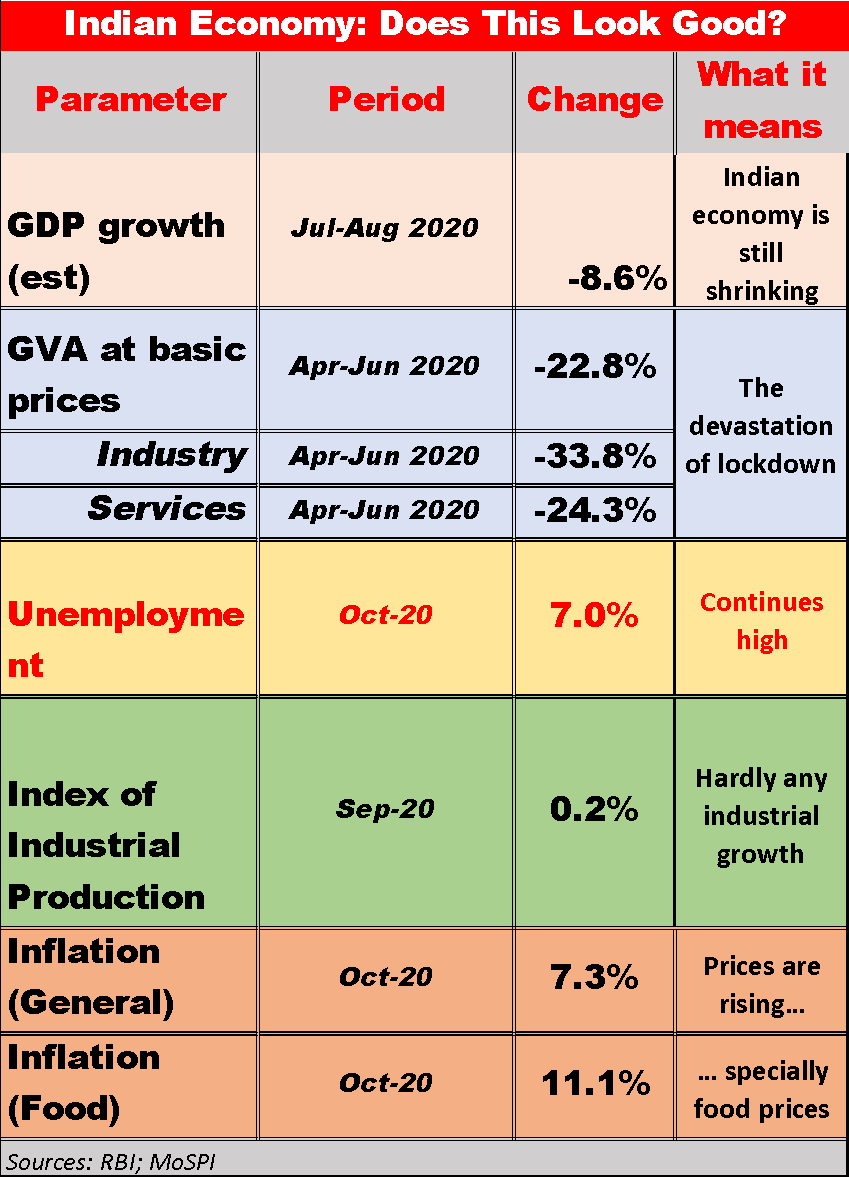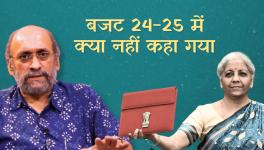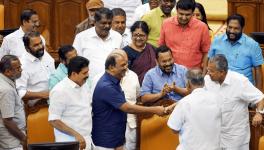Which World Is FM Sitharaman Living In?
On Thursday (November 12), Finance Minister Nirmala Sitharaman held one of her much hyped press conferences to announce a new set of measures to boost the economy. She prefaced the announcements by giving a series of numbers to supposedly show that the sinking Indian economy is actually on the brink of growth and revival. This was rather ironic considering that just a day earlier, the Reserve Bank of India had suggested that the economy would likely continue to shrink in the second quarter (July-September) of this fiscal year.
In a ‘Nowcast’ – an analysis of the present rather than the past – contained in its periodic RBI Bulletin, it had direly said that the Indian economy would shrink by 8.6% in the second quarter, after the devastating 23% crash in the first quarter which coincided with the lockdown.
The FM quoted from the same RBI assessment to say that there is a likelihood of growth reviving in the third quarter, but did not mention the caveats that RBI had put: that inflation was a serious worry and could feed into “a loss of credibility in policy interventions and the eventual corrosion of growth impulses”; that the second wave of COVID-19 globally could lead to devastating collapse of demand; and that there lurks the risk of “stress intensifying among households and corporations that has been delayed but not mitigated”. What all this means is that the situation is very brittle or as RBI says “we live in challenging times”!
Also read: Do You Know How Much Veggies are Costing, Mr. Modi?
Here are some of the numbers that the FM failed to mention in her misplaced quest of talking up the economy up. [See chart below]

As can be seen, unemployment continues to rage unabated and was clocked at nearly 7% in October 2020. Much more serious is the CMIE data that records that there was a net decline in employment amounting to 55 lakh persons in October, indicating that the bounce back in jobs experienced after the lockdown started to be eased in May this year has petered out. In fact, CMIE says that labour participation rate was 40.66% in October, lower than the level in February this year before the lockdown. It has never been below 42% except during the lockdown months.
As the RBI analysis records, the industrialists are actually doing well – their profits are up despite sales being down. This can only happen if their operating expenses are cut – by throwing out workers and cutting their wages (or increasing their workload). The report says that “among 887 non-financial listed companies that have declared results so far (constituting around four-fifth of the market capitalisation of all listed non-financial companies), sales remained in contraction in Q2, although at a moderated pace relative to Q1. Expenses of these companies, however, fell faster than sales in the quarter ending September 2020, resulting in a sharp rise in operating profits after two consecutive quarters of contraction. With other income increasing moderately, net profits rose strongly.”
Also read: Sacked -- 50 lakh Industrial Workers, 62 Lakh Professional Employees
As it turns out, even the much welcomed “green shoots” like rise in output of automobile manufacturers is rejected by none other than the Federation of Automobile Dealers’ Associations (FADA), which the RBI report quotes to say “sales of two-wheelers and passenger vehicles declined by 27% and 9%, respectively, in October 2020. The decline was sharper in the case of commercial vehicles and three-wheelers, which registered a contraction of 30% and 65%, respectively.”
Dodgy Numbers
Sitharaman also presented a slew of numbers, cherry-picked to indicate a revival of the economy. These included increase in railway freight tonnage, bank credit growth, increase in Foreign Direct Investment, and so forth. Some of this is dodgy – for instance, growth of bank credit by 5.1% in September 2020 is correct but she fails to mention that last year in the same month, bank credit was growing at 8.8%. Other numbers only go to show that the pent up demand in the economy (suppressed by the lockdown and COVID-19) is being released, but it is still significantly low and way below the levels required to be called a boost.
Apart from the fact that consumer spending is muted, a damning statistic that Sitharaman has not mentioned is that bank deposits have grown 10.5% in September 2020. This means that people prefer to hold on to whatever money they have rather than spend it. This is a typical characteristic of a crisis situation, and indicates that people’s confidence is not much in things improving. It also reflects the uncertainty of incomes, forcing people to save for contingencies where their consumption spending would need to be met by using savings – which is what happened in the heartless and misconceived lockdown.
New Policy Package
Sitharaman also announced a raft of measures for further helping the limping economy. These continue the same policy of not much of government spending but rather, easing of credit in the hope of investments increasing. The last such major announcements were done in May. Five distressing months later, the Modi government continues to push the same kind of measures in the face of a miserable failure to either revive the economy or bring relief to the people.
Take, for example, the so-called ‘employment boosting’ measures, which consist of government paying the Provident Fund contribution of both employers and employees in the case of new appointments of such workers that lost their jobs since March. The amount of subsidy is too small and in any case, new appointments will not be driven by PF expenses but by demand for products. Unless there is a demand, why will employers expand production? This is the kind of tinkering – with some crumbs thrown to employers – that the government has been passing off as relief measures.
The Finance Minister said that the new package would amount to Rs 2.65 lakh crore which is about 15% of India’s GDP. But calculations show that in reality, government spending would be only about Rs 1.2-1.5 lakh crore, primarily on account of the additional fertiliser subsidy of Rs 65,000 crore. The Production Linked Incentive scheme that is pegged at Rs 1.45 lakh crore is actually spread out over eight years and may end up involving spending of not more than Rs 20,000 to Rs 22,000 crore this year. The rest of the package is all credit, apart from PM Awas Yojana, COVID research etc.
In short, the Modi government continues to pretend to be doing a lot, spinning out numbers at will and patting itself on its back, while the people of the country continue to be ground down by both, the COVID-19 pandemic and economic distress.
Also read: Modi Govt’s Bizarre Economic Policy: Borrow More But Spend Less!
Get the latest reports & analysis with people's perspective on Protests, movements & deep analytical videos, discussions of the current affairs in your Telegram app. Subscribe to NewsClick's Telegram channel & get Real-Time updates on stories, as they get published on our website.
























